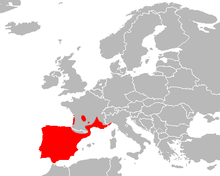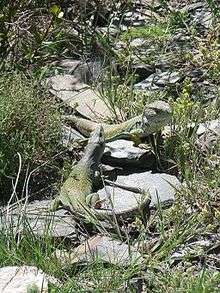Ocellated lizard
| Ocellated lizard Timon lepidus | |
|---|---|
 | |
| Scientific classification | |
| Kingdom: | Animalia |
| Phylum: | Chordata |
| Class: | Reptilia |
| Order: | Squamata |
| Suborder: | Sauria |
| Family: | Lacertidae |
| Genus: | Timon |
| Species: | T. lepidus |
| Binomial name | |
| Timon lepidus (Daudin, 1802) | |
| Subspecies | |
|
T. l. ibericus López-Seoane, 1884 | |
 | |
| Synonyms | |
|
Lacerta lepida Daudin, 1802 | |
The ocellated lizard, eyed lizard or jeweled lacerta in the pet trade (Timon lepidus) (syn. Lacerta lepida) is a species of wall lizard also known as the (Portuguese: sardão, Spanish: lagarto ocelado).
Description
Timon lepidus is one of the largest members of its family. The adult is 30 to 60 cm (0.98 to 1.97 ft) long and may reach up to 90 cm (3.0 ft), weighing more than 0.5 kg (1.1 lb).[2] About two-thirds of its length is tail. Newly hatched young are 4 to 5 cm (1.5 to 2 in) long, excluding tail.
This is a robust lizard with a serrated collar. The male has a characteristic broad head. It has thick, strong legs, with long, curved claws. The dorsal background colour is usually green, but sometimes grey or brownish, especially on the head and tail. This is overlaid with black stippling that may form a bold pattern of interconnected rosettes. The underside is yellowish or greenish. The male is brighter in colour than the female and has blue spots on its flanks; there are fewer or none in the female. Young are green, grey, or brown, with yellowish or white, often black-edged, spots all over.

Distribution
Timon lepidus is native to southwestern Europe. It is found throughout the Iberian peninsula (Spain, Portugal), and is patchily distributed in southern France and extreme northwestern Italy. The range for each subspecies is:
- Timon lepidus ibericus - northwestern Iberian Peninsula (Spain and Portugal)
- Timon lepidus lepidus
- Timon lepidus nevadensis - southeastern Spain
- Timon lepidus oteroi
Ecology and Conservation
This reptile is found in various wild and cultivated habitats from sea level up to 2100 m in southern Spain. It is rare at higher altitudes. It prefers dry, bushy areas, such as open woodland and scrub, old olive groves and vineyards, and is sometimes found on more open, rocky or sandy areas. It can occasionally be seen basking on roadsides. The lizard usually stays on the ground, but climbs well on rocks and in trees. It can dig holes and sometimes uses abandoned rabbit burrows.
This lizard feeds mainly on large insects, especially beetles, and also robs birds’ nests and occasionally takes reptiles, frogs, and small mammals. It also eats fruit and other plant matter, especially in dry areas.
Breeding occurs in late spring or early summer. Males are territorial in spring and fight in the breeding season. The female lays up to 22 eggs in June and July about three months after mating, hiding them under stones and logs or in leaf litter or in loose damp soil. It tends to lay fewer, larger eggs in dry areas. The eggs hatch in eight to 14 weeks. The lizard is sexually mature at two years of age.
Gastronomy
The ocellated lizard was part of the traditional cuisine of Extremadura, Spain.[3] In this region, the lizard was usually prepared in guisado, made by frying slices of lizard in olive oil, after which they were stewed over a slow fire.[4][5][6]
This species is currently under protection in Spain; capture and trade is forbidden.[7]
See also
References
- ↑ Juan M. Pleguezuelos; Paulo Sá-Sousa; Valentin Pérez-Mellado; Rafael Marquez; Marc Cheylan; Claudia Corti; Iñigo Martínez-Solano (2009). "Timon lepidus". IUCN Red List of Threatened Species. Version 2014.2. International Union for Conservation of Nature. Retrieved 25 October 2014.
- ↑ http://www.biotropics.com/englisch/html/timon_lepidus.html
- ↑ Gastronomía extremeña
- ↑ Lorenzo Díaz, (2001), Los sabores perdidos, Ed. Edaf. pag. 178 Gastronomia extremeña
- ↑ Gastronomía tradicional extremeña
- ↑ Los hábitos culinarios en el pasado extremeño
- ↑ Real Decreto 139/2011, de 4 de febrero, para el desarrollo del Listado de Especies Silvestres en Régimen de Protección Especial y del Catálogo Español de Especies Amenazadas
External links
| Wikimedia Commons has media related to Timon lepidus. |
- SRSWWW server at EMBL-Heidelberg
- All about keeping and breeding of the beautiful-ocellated Lizards Timon Lepidus!
- Photos at www.herp.it
- Information about the Ocellated Lizard
